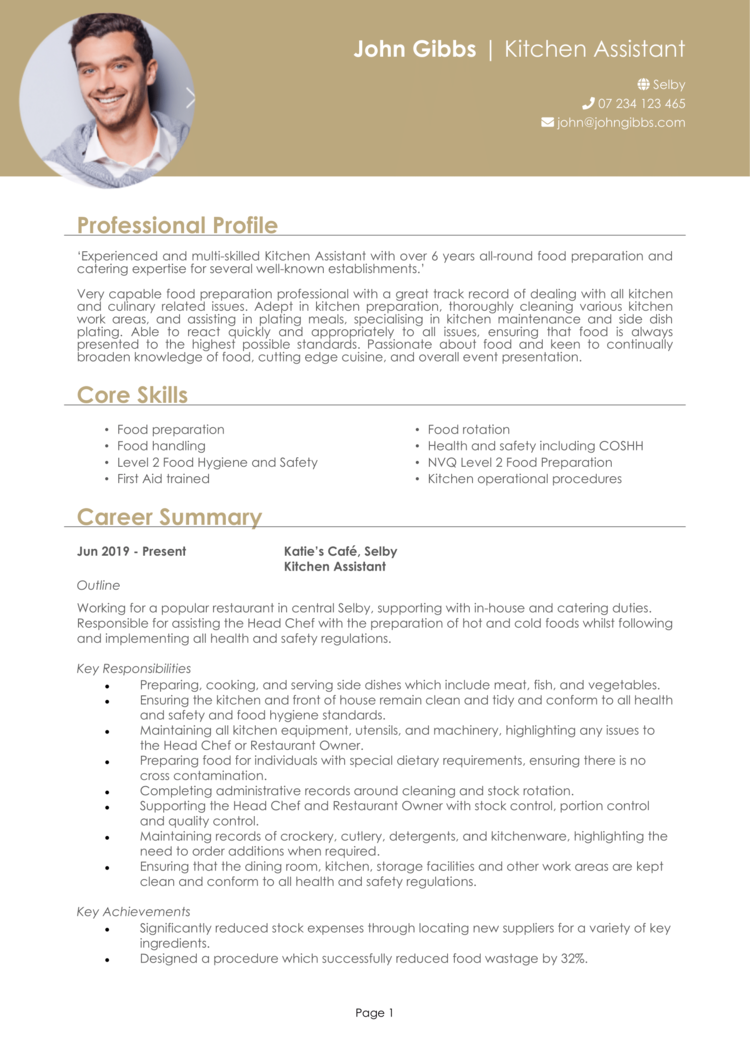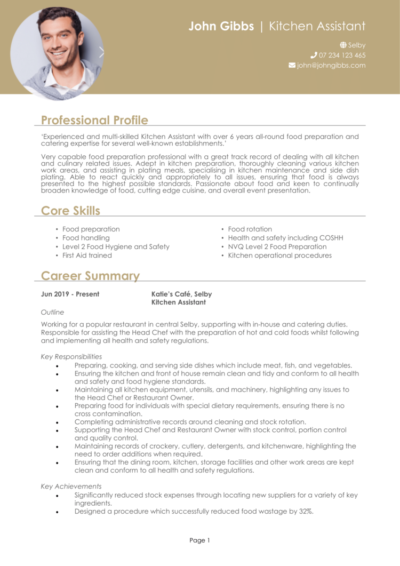A great kitchen assistant is like a secret ingredient – working behind the scenes but making sure everything turns out just right. Whether you’re prepping ingredients, keeping the kitchen spotless, or making sure chefs have everything they need, your role is crucial in keeping service running smoothly.
But before you can step into the heat of the kitchen, you need to get past the first challenge: landing the job. This guide and its 2 Kitchen Assistant example CVs will show you how to highlight your experience, skills, and ability to work under pressure – helping you secure a role where you’ll be an essential part of the team.
Kitchen Assistant CV

Kitchen Porter CV

How to write your Kitchen Assistant CV
Learn how to create your own interview-winning Kitchen Assistant CV with this simple step-by-step guide.
This guide will walk you through writing a CV properly, showcase your most important skills, and present your experience in the best way possible. By the time you’ve finished reading, your CV will be as sharp as a freshly honed chef’s knife.
Kitchen Assistant CV structure


A kitchen without order is a recipe for disaster – same goes for your CV. A clear and organised CV structure makes it easy for employers to see that you’re the right fit for the job. Keep your layout coherent so hiring managers can find your key strengths at a glance.
Here’s the structure you should follow:
- Name and contact details – Place contact details at the top so employers can get in touch easily; you could also add an optional photo of yourself.
- Profile – Kick things off with a concise overview of what makes you the ideal candidate for the job, discussing your reliability and ability to thrive in a kitchen environment.
- Core skills – Briefly highlight those qualities which make you the best candidate, such as food prep, hygiene standards, and teamwork.
- Work experience – Detail your previous roles in reverse chronological order, focusing on responsibilities and achievements.
- Education – Go through the academic history which underpins your expertise, from degrees to certificates.
- Additional info – This optional section can include professional memberships, awards, or hobbies that show you’re a good fit.
Kitchen Assistant CV format


A cluttered CV format won’t impress a hiring manager – just like a cluttered kitchen won’t impress a head chef. Keep your layout professional and simple, because even the most qualified kitchen workers will lose out over formatting mistakes.
Follow these formatting tips:
- Bullet points – Use these to highlight key skills and achievements quickly and clearly.
- Divide sections – Separate parts of your CV logically so it’s easy to navigate.
- Use a clear and readable font – Stick to professional and clean fonts, and a sensible colour scheme.
- No more than 2 pages – Keep it a concise length to maintain their interest while still covering all the essentials.
What is a Kitchen Assistant CV profile?


Your CV profile is your chance to introduce yourself and show why you’d be a valuable kitchen assistant. This short section should highlight your experience, key strengths, and what you bring to a fast-paced kitchen environment.
Kitchen Assistant CV profile examples
Profile 1
Hardworking Kitchen Assistant with two years of experience supporting chefs in high-paced restaurant environments. Skilled in food preparation, maintaining cleanliness, and ensuring compliance with food hygiene standards. Proficient in handling kitchen equipment, washing dishes, and assisting with stock management. Works well under pressure and as part of a team.
Profile 2
Reliable Kitchen Assistant with one year of experience in cafés and catering services. Adept at preparing ingredients, cleaning workstations, and assisting with basic cooking tasks. Knowledgeable in food safety protocols and maintaining an organised kitchen environment. Enthusiastic about supporting kitchen teams in delivering high-quality meals.
Profile 3
Experienced Kitchen Assistant with over three years of expertise in assisting chefs, handling food prep, and ensuring smooth kitchen operations in busy hotels and restaurants. Skilled in stock rotation, waste management, and following HACCP guidelines. Committed to maintaining a safe and hygienic workspace while supporting the efficient delivery of meals.
What to include in your Kitchen Assistant CV profile
Let’s break down what makes a strong kitchen assistant profile:
- Your kitchen experience – Have you worked in restaurants, cafés, hotels, or catering?
- Key strengths – Are you fast, reliable, and able to work well under pressure?
- Understanding of food hygiene – Employers want to see that you know how to keep a kitchen safe and clean.
- Teamwork skills – A kitchen only works when everyone supports each other.
- Any additional training – If you have food safety or health and safety qualifications, mention them here.
Show off the core skills recruiters look for


A core CV skills section gives employers a quick way to assess whether you have what they’re looking for. Since kitchen assistant roles vary, make sure your listed skills match the job description.
For example, if the role is in a high-end restaurant, focus on precision and food prep skills. If it’s a large-scale catering kitchen, tell recruiters about your skills in teamwork and efficiency.
What to include in a Kitchen Assistant CV core skills section
- Food Preparation – Assisting chefs by chopping, peeling, and portioning ingredients for meal preparation.
- Dishwashing and Cleaning – Maintaining cleanliness by washing dishes, utensils, and kitchen equipment efficiently.
- Workstation Sanitisation – Cleaning and disinfecting food preparation areas to meet hygiene and safety standards.
- Stock Rotation and Organisation – Managing inventory, checking expiry dates, and ensuring proper food storage.
- Basic Cooking Assistance – Supporting chefs with simple cooking tasks such as assembling dishes and plating food.
- Waste Management – Disposing of food waste and managing recycling according to kitchen policies.
- Health and Safety Compliance – Following food hygiene regulations and safety protocols to prevent contamination and accidents.
- Equipment Handling – Using kitchen appliances like blenders, slicers, and fryers safely and efficiently.
- Assisting with Deliveries – Receiving and storing food supplies, ensuring quality and stock accuracy.
- Teamwork and Communication – Working closely with chefs and kitchen staff to maintain smooth kitchen operations.
Work experience


Your work experience should do more than just list your previous jobs – it should show how you contributed to the kitchen’s efficiency and success.
List your roles in reverse chronological order, keeping each entry structured with bullet points. If you don’t have formal kitchen experience, highlight transferable skills from hospitality, retail, or customer service roles.
Structuring your jobs

- Outline – Introduce the kitchen, the type of establishment, and your role.
- Responsibilities – List your main tasks, such as assisting chefs, maintaining hygiene, and preparing ingredients. Use action words like “assisted”, “prepared”, and “maintained”.
- Achievements – Show your impact, whether it’s improving efficiency, keeping high hygiene standards, or being recognised for reliability.
Example jobs for Kitchen Assistant
Kitchen Assistant | Riverside Restaurant
Outline
Assisted chefs in preparing ingredients and maintaining kitchen cleanliness to support efficient food service in a high-volume restaurant.
Responsibilities
- Prepared vegetables, meats, and sauces under chef supervision.
- Ensured all kitchen equipment and surfaces were cleaned and sanitised regularly.
- Assisted with stock rotation and organised ingredient storage to maintain freshness.
- Disposed of waste and maintained compliance with food hygiene and safety regulations.
- Worked as part of a team to ensure smooth service during busy periods.
Achievements
- Helped reduce food waste by 15 percent by improving stock management.
- Recognised by chefs for reliability and efficiency in food preparation tasks.
- Maintained a spotless kitchen environment, contributing to a 5-star hygiene rating.
Kitchen Assistant | Hotel Overpass
Outline
Provided essential support to kitchen staff in a busy hotel restaurant, ensuring seamless meal preparation and service.
Responsibilities
- Washed, peeled, and chopped ingredients to assist in meal preparation.
- Managed dishwashing and cleaned kitchen surfaces to maintain hygiene standards.
- Helped unload and store deliveries, ensuring stock was organised correctly.
- Followed food safety procedures to prevent cross-contamination.
- Assisted with plating and presentation during peak service times.
Achievements
- Reduced service delays by improving kitchen organisation and food prep efficiency.
- Recognised by head chef for maintaining excellent kitchen hygiene.
- Assisted in menu prep for large-scale banquets, ensuring smooth food service.
Kitchen Assistant | Central Coffee
Outline
Supported kitchen operations in a fast-paced café, helping chefs with food preparation and maintaining a clean working environment.
Responsibilities
- Prepared sandwiches, salads, and light meals according to café menu standards.
- Kept kitchen equipment clean and ensured proper storage of ingredients.
- Handled dishwashing duties, ensuring plates and utensils were available during service.
- Assisted in portion control and meal assembly for takeaway orders.
- Followed all health and safety regulations to ensure a compliant kitchen environment.
Achievements
- Improved food preparation efficiency, reducing wait times for customers.
- Contributed to maintaining a high standard of food hygiene and safety.
- Recognised for reliability and teamwork in a busy café environment.
How to write your education section


Formal qualifications aren’t always necessary for a kitchen assistant role, but if you have any relevant training or certifications, make sure to include them. Recruiters are interested to see the foundational education that underpins your skills, even if they value experience more.
If you’ve completed food safety courses, health and safety training, or a hospitality-related qualification, highlight them here.
Best qualifications for Kitchen Assistants
- Level 2 Food Hygiene & Safety Certificate – Essential for maintaining cleanliness and food safety.
- Manual Handling Training – Important for lifting heavy stock and equipment safely.
- First Aid at Work Certification – Useful in fast-paced kitchen environments.
- COSHH (Control of Substances Hazardous to Health) Training – Ensures safe handling of cleaning chemicals.
- Fire Safety Awareness Training – Beneficial in a kitchen where fire hazards are common.





